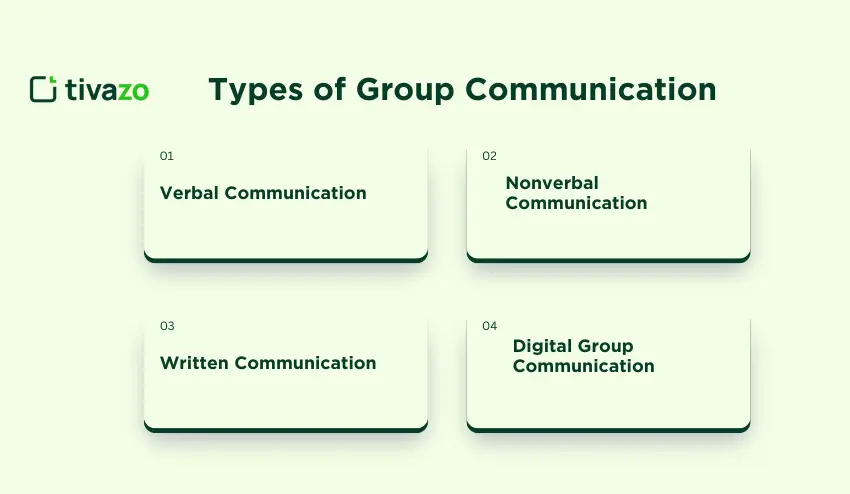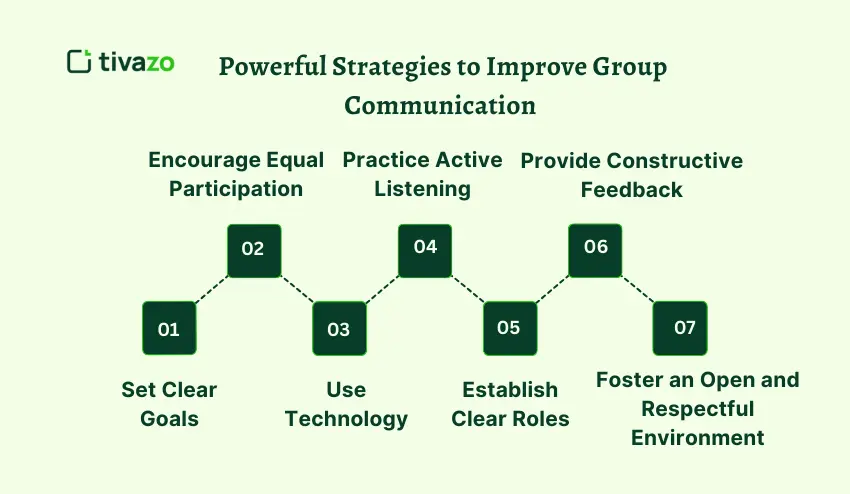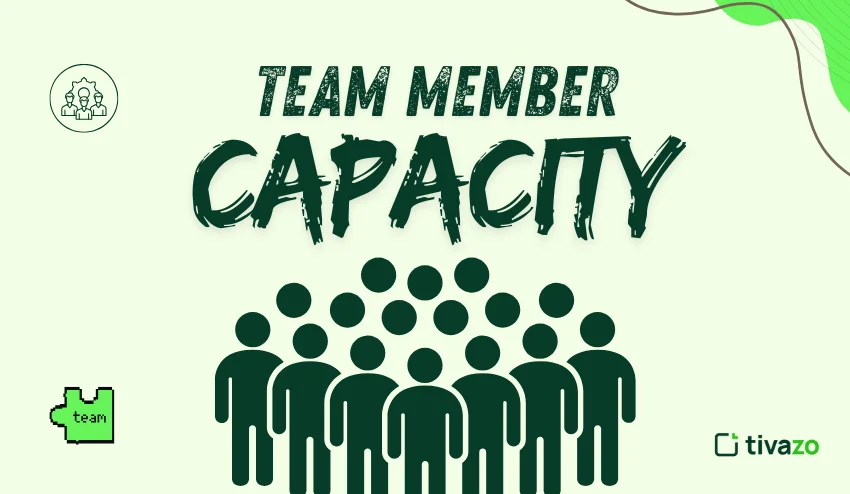We can all agree, life today goes by incredibly quickly! Workplaces are busier than ever, projects are more complicated than ever, and collaboration quite often spans across time zones, too. In such a fast-paced environment, group communication is the backbone of success.
When people experience group communication enabled by good management, there is a free-flow of ideas, conflicts are resolved faster, and groups experience a sense of unity called teamwork. Communication breaks down and all of a sudden, we have misunderstandings, low productivity, and low morale.
This blog post will break down what group communication is, why group communication matters, and the 7 strategies you can implement today to improve group communication in your workplace, school, or community.
What is Group Communication?
Group Communication is when ideas, thoughts, and information are exchanged between members of a group to achieve shared goals. Unlike individual communication, which takes place between two people, group communication involves several contributors sharing information at the same time.
Example: A marketing team brainstorming ideas for a new campaign, a classroom activity that is discussion-based, a remote team meeting on Zoom, etc.
Group communication is not only about talking, but it is also about listening, interpreting, and responding in ways that are in line with the group’s purpose.
Why Group Communication Matters in Today’s World
We all live in a world that is designed to support collaboration. No major advancement happens without the effective use of acquired group communication skills in business, education, or social engagements. Group communication is no longer a “nice-to-have,” it has evolved to be the foundation of how people work, learn, and grow together.
Here’s why it matters more than ever:
- Increases Productivity – When everyone is clear on goals, timelines, and responsibilities, there is no duplicated work or wasted time keeping projects on track.
- Builds Trust – Communicating and sharing ideas freely builds a sense of belonging, and team members develop a sense of trust when they feel their voice is valued.
- Stimulates Innovation – Different thinking brings ideas, and ideas create creativity. Group communication provides a channel for one person to share their idea or concept, and that may create more great ideas.
- Reduces Misunderstanding – Miscommunication creates conflict in the workplace; ongoing group communications eliminate the assumptions that can exist about understanding.
- Provides Opportunities for Remote Teams – Digital tools create opportunities for collaboration, bringing people together regardless of locational time zones to and allowing them to function as if they were in the same space.
💡 The shorter answer is that great group communication amazing results, leading a start-up, a classroom, and even on a global scale.
Types of Group Communication
Types of Group Communication are:

1. Verbal Communication
Includes face-to-face conversations, brainstorming, and presentations. It’s quick, interactive, flexible, and allows ideas to flow easily with real-time feedback.
2. Nonverbal Communication
Body language, tone, and facial cues give significance to verbal messages; they often communicate emotions or attitudes that we do not say and build trust in a group setting.
3. Written Communication
Emails, reports, and chat messages document the conversation; these messages are easy to follow, best used for instructions or documentation, and help communicate ideas while keeping everyone on the same page.
4. Digital Group Communication
Video chats, online discussion forums, and different types of communication and collaboration apps (i.e., Zoom, Teams) combine different forms of communication to give a multi-form medium. Digital group communication can overcome time differences and allow teams to operate seamlessly.
Each of these forms of communication is valuable in its own right. Mastering all four types will bring clarity in communication, collaboration, and productive results for any group.
Benefits of Effective Group Communication
When group communication goes well, the outcomes can be impactful and visible in every area of teamwork:
✅ Higher productivity – Efficient communication minimizes miscommunication, avoids duplicated efforts, and ensures tasks are completed right from the start.
✅ Better collaboration – Open sharing of ideas encourages creativity and innovation, as everyone contributes their unique perspective.
✅ Conflict resolution – Early identification and resolution of misunderstandings can stop small misunderstandings from becoming larger team problems.
✅ Team bonding – Team members want to feel heard, important, and respected. When team communication is effective, trust will be more strongly built, allowing for more group trust.
✅ Stronger decision-making – Collaboration ensures all critical viewpoints are explored and discussed before making decisions. This gives the team as a whole an opportunity to make better, more rounded decisions.
💡 To summarize, effective group communication can positively impact not only outcomes but also motivation and positivity within team approaches.
Common Barriers in Group Communication
Even strong teams struggle with communicating. Knowing your barriers to communication is the first step to correcting them:
Lack of Clarity
Vague instructions, goals, and expectations can leave team members unsure, leading to mistakes, missed deadlines, and frustration. Always provide the clearest messaging possible to help everyone get aligned.
Information Overload
Too much information at once (think endless emails, messages, or reports) can overwhelm team members. When team members’ attention starts to fade, they overlook important details, causing delays or miscommunication. Prioritizing and summarizing the most relevant information are ways to help combat information overload.
Cultural or Language Differences
Global teams can be a real asset, but it also bring an added level of complexity. Language barriers, different communication styles, and cultural differences can all lead to miscommunication. For example, a casual comment or joke from one team member may not translate similarly to another culture. Be aware, and be sensitive.
Dominant vs. Silent Members
There are always those team members who grab the microphone or dominate discussions, while others hesistate to share ideas. This creates an imbalance and inhibits a larger exchange of ideas and reduces creativity, and ultimately limits the problem-solving process. Being attentive to and inviting equal voice participation ensures that everyone’s voice is heard.
Remote Work Challenges
Technical glitches, time zones, working from home distractions can all interrupt group communications in a remote team. Without proper tools and rituals, messages get lost, people show up to meetings late or not at all, meetings have multiple problems that interrupt flow,
💡 The solution: Addressing these obstacles along with establishing clear strategies e.g. Responsibilities meetings, active listening and substantive application of digital platforms can maximize communication and results in group performance.
7 Powerful Strategies to Improve Group Communication
Now here’s the part you’ve been waiting for the practical ways to enhance group communication.
Effective group communication does not happen by accident. It takes clear focus and practical strategies. Below are seven practical strategies to enhance communication in any group setting:

1. Set Clear Goals Before Every Discussion
Each group discussion needs to have a clear rationale. Whether it is a team meeting, a brainstorming session, or an organizational project update, the process of creating an agenda helps participants stay on task and you avoid wasting everyone’s time. Explicit goals reinforce the groups understanding of the agreed upon outcomes which everyone can actively participate in.
2. Encourage Equal Participation
Across every group, you will have many who dominate the conversation, and others will shy away and not openly contribute. To be sure that your group is operating at full potential you want to ensure everyone is equally contributing. While it may differ according to the group’s context, leaders can ask an individual a question-directly, a group of individuals can also have a turn at speaking or designate breakout groups and allow for each individual to make an active contribution.
3. Use Technology to Bridge Gaps
In today’s world, remote and hybrid teams tend to leverage technology to remain connected. Communication and task management tools like Zoom, Slack, and Trello provide efficient structures for communication. Using various teams ensures information is shared and processing in real time, and the chance for information to get lost is minimized.
4. Practice Active Listening
Good communication has more to do with listening than talking. Active listening is listening and then summarizing what you have heard, asking questions that seek clarification, or confirming your understanding. Listening actively will avoid misunderstandings, create trust, and show all team members that they and their thoughts are valued and matter.
5. Establish Clear Roles and Responsibilities
When people understand exactly what their role is within a project or conversation, it decreases confusion and increases accountability. Clear roles also prevent people from taking on each other’s tasks, avoid unnecessary conflict, and allows for the tracking of progress. Services with clearly defined responsibilities will run smoothly and confidently.
6. Provide Constructive Feedback
Providing feedback means offering the potential for a change or improvement but should be focused on the solution, not personal. Constructive feedback points out where improvements are needed and why improves that will change and offers options for how to do it. This type of open, non-confrontational language provides opportunities for learning, creates trust, and improves, while not breeding resentment or discouragement.
7. Foster an Open and Respectful Environment
Psychological safety is key to group communication. When members feel respected and safe to produce ideas even bad or unusual ones, they are more likely to participate openly. Leaders can foster respect by recognizing contributions, addressing conflict appropriately, and demonstrating inclusive or respectful language and behaviors.
💡 Main takeaway: If you consistently implement these seven strategies you’ll change communication, strengthen collective collaboration and empower the team for better results.
How Leaders Can Enhance Group Communication
Leadership makes a difference in how well a group communicates. Great leaders understand the difference between merely managing groups and modeling how to communicate with each other that is open, respectful, and productive. Here are some ways to improve communication:
- Lead by example – When leaders listen, communicate clearly, and are respectful, they model the expectation of how the rest of the team should interact. This behavior will inspire and encourage the rest of the group to do the same.
- Mediate conflicts calmly – Disagreement is part of a team dynamic. Effectively leading may mean fixing something that a member of the group messed up or getting the group focused on solving conflict and not blaming or pointing fingers.
- Empower quieter members – Not everyone speaks up naturally. This means that when leading, you can create space for that shy or quiet member by directly asking for their input, creating a system that allows the group to hear all members through keeping the input structured or perhaps by breaking the group into smaller groups to discuss.
Tools That Support Group Communication
Tools can greatly improve how teams communicate, especially the challenges of the new world, where a note, memo, or an email is wasted effort, and there’s less room for misunderstanding. As we incorporate different tools into our work, group communication can get faster, more organized, and efficient.
- Slack – direct messages or chat via a slack channel where people can comment in real-time.
- Microsoft Teams – a channel for meetings, chat, and documents all in one place.
- Zoom – for video calls and webinars, it’s the fastest way to communicate from anywhere
- Google Docs – create a live document and work on it, edit, and share it with the group in the moment.
- Trello / Asana – group project task management system, where people can see what’s going on and assign tasks.
💡 Each tool has its virtues and strengths. Use them wherever necessary, depending on your team size, workflow processes, changes, and communication requirements.
Future of Group Communication
Group communication is changing rapidly, thanks to technology and the desire for more collaborative ways to work together. Teams will be able to work smarter, faster, and be geographically separated.

- AI-based assistants – Artificial intelligence programs can summarize meetings automatically, identify relevant follow-up action items, and even recommend who to follow up with. AI assistants can save you time and ensure no important detail remains unattended.
- Real-time translation – Thanks to Artificial Intelligence, language barriers will be considerably less of an issue when multicultural teams discuss ideas. AI will empower teams to have instantaneous translation in the discussion.
- Virtual reality (VR) ‘work space’ – VR technology will provide teams’ use of multi-sensory environments where team members can meet, brainstorm, and work on projects as if they are in a shared physical location, even if they are distributed throughout the world.
💡Take away: Our group communication activity tomorrow is unlikely to be just a verbal or written piece of communication; it likely will encompass a multitude of technologies that allow the team to work together in ways that as of today are more efficient, inclusive, and effective than ever before.
Conclusion
Communication within groups is more than just communicating. Group communication is about bridge building. Whether it is increasing productivity to fostering stronger human connection, communication is essential in laying the ground work for desired outcomes.
Keep the 7 strategies in mind: goal setting, participation, use of tools, active listening, assigning roles, feedback, and respect.
Try even one today and you will see your team begin to work smarter, faster and with a collective purpose.




